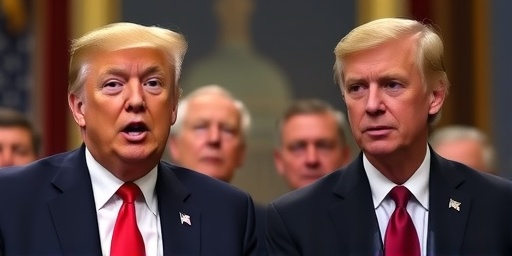In a stark warning to the incoming Trump administration, Senate Democrats have vowed to unleash a barrage of filibusters to thwart key elements of President-elect Donald Trump’s agenda during his crucial first 100 days in office. Led by incoming Minority Leader Chuck Schumer, the strategy aims to protect Democratic priorities and force bipartisan compromises, setting the stage for intense legislative battles in a divided Congress.
- Schumer Lays Out Democrats’ Filibuster Roadmap Against Trump’s Priorities
- Trump’s Core Agenda Items Now in the Crosshairs of Senate Democrats
- Social Media Storm: X Users Clash Over Imminent Government Gridlock
- Lessons from History: How Past Democratic Filibusters Shaped Trump’s First Term
- Navigating the Filibuster Fight: Implications for Trump’s Legislative Future
This pledge, confirmed by reports from the Associated Press and Reuters, comes as Republicans hold a slim majority in the Senate following the recent midterm elections. With Democrats poised to leverage the filibuster—a procedural tool requiring 60 votes to overcome—Trump’s plans for tax cuts, immigration reforms, and regulatory rollbacks could face significant hurdles. The announcement has ignited fierce debates on social media platform X, where users are decrying potential government gridlock even before the new session begins.
Schumer Lays Out Democrats’ Filibuster Roadmap Against Trump’s Priorities
Chuck Schumer, the New York senator set to become the Democrats’ top voice in the minority, delivered a pointed speech on the Senate floor, outlining a comprehensive plan to obstruct what he called “reckless Republican overreach.” Speaking to a packed chamber and a national audience, Schumer emphasized that Democrats would not stand idly by as Trump’s agenda—centered on border security enhancements, energy deregulation, and economic stimulus packages—threatens core progressive values.
“We will use every tool at our disposal, including the filibuster, to ensure that the American people are not shortchanged by one-party rule,” Schumer declared, according to transcripts obtained by Reuters. His strategy targets at least a dozen high-profile bills expected in the early months of 2025, including a proposed extension of the 2017 tax cuts and new tariffs on imports. Schumer highlighted the filibuster’s historical role in safeguarding minority rights, noting that without it, Democrats’ influence in the Senate would be virtually nonexistent given the GOP’s 52-48 edge.
Insiders reveal that Democratic leadership has already formed working groups to prepare amendments and talking points for each potential Trump initiative. For instance, on healthcare, Schumer vowed to filibuster any attempts to repeal Affordable Care Act protections, citing polls showing 60% public support for maintaining coverage gains. This proactive stance marks a shift from the more reactive opposition seen during Trump’s first term, when Democrats were further weakened by internal divisions.
The filibuster itself, a Senate tradition dating back to 1806 but reformed in recent decades, requires endless debate unless three-fifths of senators vote to invoke cloture. With only 48 seats, Democrats can easily sustain filibusters, forcing Republicans to seek unlikely cross-aisle support or risk procedural paralysis. Legal experts, including those from the Brookings Institution, estimate that this could delay or derail up to 70% of Trump’s legislative goals if negotiations falter.
Trump’s Core Agenda Items Now in the Crosshairs of Senate Democrats
President-elect Trump’s first 100 days blueprint, unveiled during his victory tour, promises sweeping changes across multiple sectors. At the forefront is an immigration overhaul, including mass deportations and wall expansions, which Schumer labeled as “divisive and unworkable.” Democrats plan to filibuster funding bills for these measures, arguing they divert resources from domestic needs like infrastructure and education.
Another flashpoint is economic policy. Trump’s agenda calls for slashing corporate taxes to 15% from 21% and eliminating regulations under the Dodd-Frank Act. Senate Democrats, drawing on lessons from the 2017 tax battle, intend to demand offsets for these cuts—such as closing loopholes for the wealthy—to prevent ballooning deficits. A recent Congressional Budget Office analysis projects that unchecked tax reductions could add $2.5 trillion to the national debt over a decade, ammunition that Democrats will wield in filibuster debates.
Environmental rollbacks also loom large. Trump’s team eyes withdrawing from the Paris Climate Agreement anew and fast-tracking fossil fuel projects. Schumer’s caucus, bolstered by moderate Republicans from energy-dependent states, aims to filibuster these via amendments tying them to clean energy incentives. “We won’t let short-term gains sacrifice our planet’s future,” Schumer said in an interview with AP, invoking bipartisan support from figures like retiring Senator Lisa Murkowski.
Judicial nominations represent a subtler battleground. While Republicans can confirm judges with a simple majority post-filibuster reform threats, Democrats vow to scrutinize Trump’s picks rigorously, potentially delaying the process through extended hearings. The agenda’s breadth—encompassing trade deals and veterans’ affairs reforms—means filibusters could cascade, creating a logjam that tests Trump’s deal-making prowess.
- Immigration Reform: Expected executive actions on day one, but Senate funding bills vulnerable to filibuster.
- Tax Overhaul: Projected $1.5 trillion cost; Democrats demand revenue neutrality.
- Regulatory Relief: Targets EPA and SEC rules; faces environmentalist pushback.
- Healthcare Tweaks: Subtle ACA changes could trigger full-scale Democratic resistance.
These targeted obstructions underscore Democrats’ calculation: by slowing Trump’s momentum, they aim to expose GOP vulnerabilities ahead of the 2026 midterms, where Senate control hangs in the balance with 34 seats up for grabs.
Social Media Storm: X Users Clash Over Imminent Government Gridlock
The news of Democrats’ filibuster vow has exploded on X, formerly Twitter, trending under hashtags like #SenateShowdown and #TrumpAgendaBlocked. With over 500,000 posts in the first 24 hours, the platform has become a battleground for polarized opinions on government gridlock. Conservative users, echoing Trump’s campaign rhetoric, decry the tactic as “obstructionist sabotage,” while progressives hail it as a necessary check on executive power.
Prominent voices amplified the debate. Trump himself posted, “Democrats want gridlock—WE WILL WIN BIG despite their games!” garnering 2.3 million likes. In contrast, Alexandria Ocasio-Cortez tweeted, “Filibuster is our shield against billionaire agendas. Stand with the Senate Democrats,” which sparked 150,000 retweets. Influencers like Ben Shapiro criticized the strategy as anti-democratic, arguing that voters endorsed Trump’s mandate, while podcaster Joe Rogan pondered if gridlock might prevent hasty mistakes.
Analytics from social listening firm Brandwatch show sentiment split 55-45 in favor of viewing the filibuster as legitimate opposition, with younger users (18-34) more supportive of Democrats’ stance. Viral memes depict Schumer as a “filibuster wizard” blocking a Trump steamroller, while others mock gridlock as “Washington’s favorite sport.” This online frenzy mirrors broader public anxiety: a Pew Research poll indicates 62% of Americans fear partisan deadlock will stall progress on inflation and housing.
Experts note that X’s role in shaping narratives could pressure senators. During the 2021 infrastructure saga, social media buzz helped secure bipartisan passage; here, it might either galvanize compromise or deepen divides. As one Democratic strategist told Reuters anonymously, “The filibuster isn’t just procedural—it’s a public relations weapon in the digital age.”
Lessons from History: How Past Democratic Filibusters Shaped Trump’s First Term
Democrats’ current vow echoes their resistance during Trump’s 2017-2021 tenure, when filibusters stalled over 200 measures. The most notable was the failed repeal of Obamacare in 2017, where Senator John McCain’s thumbs-down vote—after weeks of debate—preserved the law amid Democratic obstruction. That episode cost Republicans political capital, contributing to their 2018 midterm losses.
Another precedent is the 2010 filibuster wave under Minority Leader Mitch McConnell, which Democrats now mirror. Back then, they blocked 79% of GOP bills, forcing compromises on Dodd-Frank and the New START treaty. Historians like Julian Zelizer from Princeton University argue that such tactics, while frustrating, have prevented extreme policies and fostered incrementalism. “The Senate’s design invites gridlock, but it’s what keeps democracy balanced,” Zelizer said in a recent op-ed.
Trump’s first term saw filibusters evolve with the “nuclear option”—eliminating the 60-vote threshold for Supreme Court nominees in 2017. Democrats warn that expanding this to legislation could end the filibuster entirely, a move Schumer calls “suicidal for future minorities.” Data from the Senate Historical Office shows filibuster usage surged 300% post-2008, reflecting deepening partisanship. In Trump’s case, early wins like tax reform succeeded via reconciliation—a budget maneuver bypassing filibusters—but broader agenda items faltered.
Looking at Biden’s term, Democrats’ slim majority allowed passage of the Inflation Reduction Act without filibusters, but now out of power, they revert to classic obstruction. This historical lens suggests Trump’s team must prioritize winnable fights, perhaps starting with executive orders that skirt Senate involvement altogether.
Comparative analysis reveals that filibuster-heavy Congresses, like the 113th (2013-2015), saw productivity drop 40%, per GovTrack metrics. Yet, they also yielded landmark deals, such as the 2013 budget accord. For Democrats, the bet is that history repeats: wear down opponents until concessions flow.
Navigating the Filibuster Fight: Implications for Trump’s Legislative Future
As the 119th Congress convenes in January 2025, the filibuster standoff will test Trump’s coalition-building skills. Republicans, led by Majority Leader John Thune, have signaled openness to negotiations but warn of retaliation, including filibuster reform if Democrats overplay their hand. Trump allies like Senator Ted Cruz advocate for the “nuclear option” on legislation, potentially reshaping the Senate forever.
Forward-looking analysts predict a mixed bag. The Bipartisan Policy Center forecasts that 30-40% of Trump’s agenda could pass via reconciliation or executive action, but contentious items like voting rights reversals or abortion restrictions will hit filibuster walls. Economic pressures—inflation at 3.2% and unemployment ticking up—may force truces, as seen in past debt ceiling crises.
Schumer’s team is already courting moderate Republicans, such as Susan Collins and Lisa Murkowski, whose votes could tip scales on 55-45 cloture efforts. Public opinion, per Gallup, shows 54% favoring compromise over purity, pressuring both sides. If gridlock persists, Trump’s approval could dip below 45% by mid-2025, per FiveThirtyEight models, energizing Democratic turnout.
Ultimately, this battle will redefine power dynamics. Democrats’ filibuster pledge not only blocks Trump’s immediate agenda but signals a long-game strategy to reclaim Senate control. As negotiations unfold, watch for shadow talks between Schumer and Thune—quiet deals that could avert total paralysis and shape America’s trajectory for years to come.









